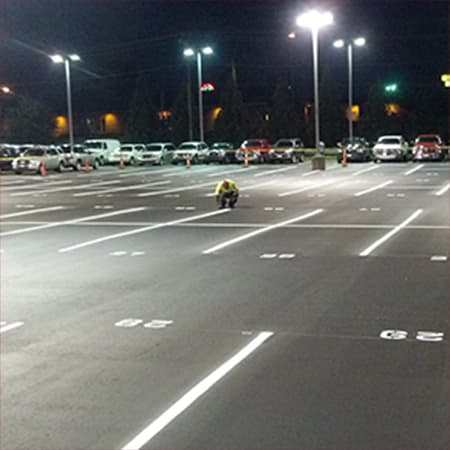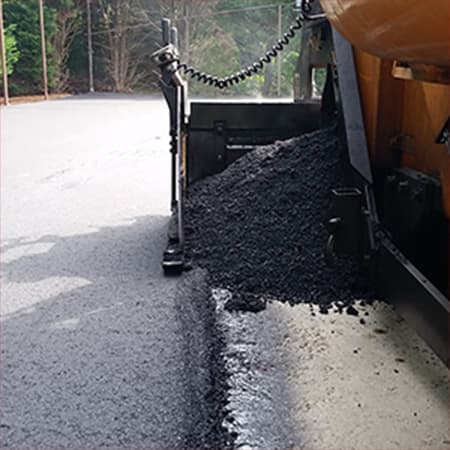Frequently Asked Questions
General Questions
Why should I choose asphalt pavement for my paving needs?
Historically, asphalt has proven to be an excellent paving material. Cost wise, asphalt provides excellent performance equal to other more expensive options.
What sort of maintenance is required to prolong the life of your parking lot?
It is recommended that an asphalt parking lot be maintained regularly to prevent the surface from deteriorating, to slow the formation of stress cracks, and also to maintain the aesthetics of your property. We recommend annual preventative maintenance such as crack-filling when new cracks occur. Sealer should be applied to your lot approx. every two years depending on the traffic and wear that you see. Corrective maintenance is necessary when excessive cracking occurs or other structurally failed areas develop. This type of maintenance includes pothole filling, asphalt removal and replacement (localized patching), overlay/resurface, or a complete removal and replacement.
Do you provide free estimates?
Yes. When you contact us, we put you in touch with one of our experienced estimators who will then typically visit your site, assess your needs and provide a detailed estimate, free of charge.
Do you perform residential work?
We are a commercial / industrial contractor and we generally do not do residential work unless it is on a commercial level such as HOA’s, apartment complexes, community associations, etc. We have made significant investments in equipment geared towards these types of projects and that can impact our competitiveness with regards to residential work.
Can asphalt be recycled?
Asphalt has been the most recycled material in America for over twenty years! We recycle asphalt pavement in several ways including cold milling, pulverization, and portland cement stabilization. Any asphalt removed from a job is returned to an asphalt plant for use in future hot asphalt mix. North Carolina allows up to 40% recycled asphalt product in their new asphalt mixes.
Will my business be impacted during your work?
Project phasing, maintaining safe conditions, and keeping businesses operating is one of the areas that distinguishes good contractors from bad contractors. We minimize your impact through proper planning and well marked access and control of work zones. We will work with you to develop a work plan that will allow your business to continue to operate while the work takes place. Furthermore, our crews work quickly and efficiently to get the project completed as soon as possible. We are often told by our customers that the project took less time than anticipated.
Paving
What is asphalt made of?
Asphalt pavement mixes are typically composed of 5% asphalt cement and 95% aggregates (stone, sand, and gravel). Due to its highly viscous nature, asphalt cement must be heated so it can be mixed with the aggregates at the asphalt mixing facility.
How long will my new asphalt surface last?
Under normal conditions asphalt pavement should last about 10 – 20 years. Pavement life can vary greatly depending on climate, base conditions, amount and type of traffic, and pavement maintenance.
What is the minimum temperature for paving?
50 degrees and rising is typically what we recommend as a minimum. There are other mitigating factors affecting the final product. This includes weather and material types being used.
How long should I stay off the new asphalt?
Normally, 24-hours is all that is required to use your new asphalt surface. In very warm weather, we recommend staying off the fresh asphalt for 1 – 2 days, as the surface cools and cures.
What causes blemishing on newly paved asphalt?
Power steering will blemish newly paved asphalt due to the pliability of the asphalt until it has cured. These are only surface blemishes and do not affect the structural integrity. The blemishes will work in with time.
Can you pave over concrete?
Yes, it is possible to pave over concrete, but is not recommended. Reflective cracking is likely to occur as a result. Reflective cracking will typically occur along all the construction joints in the concrete or where the concrete has already cracked. This is due to expansion or contraction of the old concrete surface which then causes the asphalt above to crack as the concrete moves.
What are the major contributors to pavement deterioration?
Assuming that the initial asphalt pavement was designed and constructed properly, the primary cause of failure is the penetration of water into the asphalt base. Asphalt failure often begins with the oxidation of an untreated pavement surface which causes the asphalt to become dry and brittle. The top layer of fine particles erodes, exposing the larger aggregate and leading to small cracks on the surface. These cracks will grow if left untreated, allowing water to penetrate to the base of the pavement. When water enters the base of the pavement, the base material shifts and settles leading to further cracking and a depression in the surface. As water pools in the depressed area, the asphalt further deteriorates and becomes unstable. When the pavement reaches this stage, removal and replacement of the old asphalt is often the only remedy.
Why should I choose asphalt paving over other methods?
Asphalt is a petroleum-based product used for driveways, roads, cart/walking paths and any project that requires a smooth surface for foot traffic or motorized vehicles. Asphalt is flexible and gives during the harsh weather conditions experienced in our area. It is easily and inexpensively maintained and is aesthetically pleasing.
Asphalt Repair
When is the best time to perform asphalt repair?
Asphalt repairs can be performed year round, provided we have dry conditions and temperatures greater than 50 degrees. March through November are typically good months for this. The key is to address any needs prior to the winter to avoid water penetrating and freezing within your pavement system.
What causes potholes to form?
Possible causes of potholes include asphalt that was too thin, base failure under heavy loads, or poor drainage that weakens the subgrade and base. Poor quality (segregation in the asphalt, poor compaction, or asphalt that was burnt or did not have enough oil mixed into it) may be a contributing factor.
What causes asphalt to alligator?
Generally stay off until the next day or until the surface temperature reaches the ambient air temperature.
What are the different kinds of patch repairs?
Alligatoring can happen for one of two reasons. First, insufficient base. An asphalt system is usually made up of at least 6 inches of stone and 2 inches of asphalt. In cases where there is an insufficient amount of base to support the size of the vehicles that are driving on it, asphalt will begin to crack and, in some cases, wave as result of soft subsoils below the stone base. The second reason that asphalt may alligator is because of the age of the asphalt. Older asphalt becomes brittle and will start to crack because it loses flexibility. Insufficient base repairs can often be fixed by removing the alligatored asphalt and replacing it with a thicker spec. In other words if you have 2 inches of alligatored asphalt as a result of insufficient base, then the repair would probably work is removal of the 2 inches of asphalt and and additional 2 inches and replace with 4 inches of new asphalt. In the case of asphalt that is alligatoring because of old age, then simply removal and replacement of the existing asphalt is often the correct remedy.
What are the different kinds of asphalt repairs?
There are two main types of asphalt repairs procedures that will provide a suitable fix to most asphalt related issues, asphalt removal and replacement and asphalt surface patching. Asphalt removal and replacement involves the removal of the entire layer of pavement surface down to or including the stone base, depending on the condition of the stone base. The stone is then re-compacted, a tack coat is applied to the vertical surfaces or any existing asphalt that remains, and the new asphalt pavement is placed in the repair area. Surface patching is a more temporary fix and should only be considered for a surface that is in relatively good condition. This process does not involve the excavation of the existing surface or subbase. The asphalt is simply layered over the existing surface and feathered to match the in-place grade. In some cases, a rebate is milled into the surface, which eliminates the need to feather-edge the patch.
Sealcoating
What are the benefits of asphalt sealcoating?
There are many benefits to applying a seal coat to your asphalt surface. First and foremost, this type of parking lot maintenance is a cost effective option that will increase the life-span of your property. Also, pavement sealing will help to prevent water penetration to your subgrade and slow the effects of oxidation. It also makes your parking lot more flexible and resistant to gas and oil spills. Lastly, it will beautify your property by giving the effect of a brand new parking lot.
What is the difference between asphalt sealer and pavement resurfacing?
The seal coating process is a preventative parking lot maintenance process that is sprayed onto your lot in a liquid form after applying asphalt crack filler. This is similar to staining your deck. Resurfacing is the actual process of installing a whole new layer of asphalt pavement over your old surface for a more complete parking lot repair.
Does the Asphalt Sealer fill in the pavement cracks?
No, sealer will not fill in a pavement crack completely. The recommended method to asphalt crack repair is to apply a hot, rubberized asphalt crack filler product into the crack itself. This is the only way to solve your problem as it will slow the formation of new cracks. Some lots, due to a lack of parking lot maintenance, have deteriorated beyond the point of asphalt crack repair as a beneficial alternative. In these cases, your parking lot will need patch work and/or resurfacing.
How long should I wait before driving on a newly sealed surface?
The recommended wait time to allow traffic back onto your lot after asphalt crack filling and pavement sealing is 24 hours. This allows enough time for the asphalt sealer product to cure and will help prevent tracking and will also reduce power steering marks from appearing after the parking lot repair.
Should a newly paved lot be seal coated right away?
No, it is recommended that a newly paved lot be left to cure for at least one year before the first asphalt seal coat is applied.
When is the best time for a parking lot to be sealed?
The best time for parking lot maintenance such as asphalt crack filling and sealing is during the months of April through October when the temperature is at least 50 degrees Fahrenheit through the night.
Crack Repair
Why should I fill in the cracks that have developed in my parking lot with asphalt crack filler?
Asphalt crack repair should be implemented for cracks in your parking lot that are at least a quarter inch thick should be filled in with crack filler as soon as possible to prevent the further growth of that crack and also to prevent water from seeping under your asphalt surface into the subgrade.
Concrete Repair and Services
What sort of concrete services do you provide?
We specialize in curbs, curb repair and flatwork, no job is too big or too small. If we can’t do it with our own forces we know the concrete repair contractors who can and we will be with them every step of the way to assure you that it will meet our high standards and the intent of the plans.
What causes concrete to crack?
There are different types of concrete cracks. The most common of these is related to the natural shrinkage of concrete as it cures and dries. Shrinkage concrete cracking can be controlled or hidden by following proper jointing techniques. Different factors and conditions can contribute to each type of concrete cracks. It is important to understand these potential causes and take appropriate action to prevent cracking and the subsequent need concrete crack filler or concrete crack repair.
Why does some concrete develop surface deterioration?
Concrete surface deterioration is usually referred to as scaling. Scaling is a local flaking or peeling of the finished, hardened concrete surface, resulting primarily from multiple freeze-thaw cycles. The condition can be aggravated by the presence of de-icing materials such as salt. Any product that is intended to melt ice and snow can contribute to concrete scaling. Even products labeled Safe for Concrete can contribute to scaling. The probability that scaling may occur can be reduced or eliminated by using a durable concrete mix and following recommended concrete placing, finishing and curing/sealing practices performed by an experienced concrete contractor.
How soon can new concrete be put into use?
During periods of moderate to warm weather, new concrete could be opened for pedestrian traffic in twelve to twenty-four hours, or when the surface becomes scuff resistant. A general guideline is that new concrete should not be opened for vehicular traffic for a minimum of seven days. This seven-day period can be significantly reduced by using a faster setting, stronger concrete mix. Please note that concrete gains strength more slowly in colder weather so more time may be needed before putting your new concrete into use.
Cement Stabilization
What does FDR stand for?
FDR stands for full depth reclamation. This is a process that we often use on tennis courts or existing roadways. When a soft subgrade is indicated by conditions on the surface, FDR is done by stabilizing the stone base, and at times, the soil beneath the stone is incorporated to a degree. This creates a concrete bridge over soft subgrade formed by the cement and the stone matrix.
Is stabilization guaranteed to work?
Unfortunately nothing in the world of construction is guaranteed to work. Some conditions may need either additional treatment or other types of remediation. In general though, from our experience, stabilization is more effective and more cost friendly than other solutions such as undercut and replacement.
Is FDR messy?
It is dry cement so there is a lot of dust until it’s mixed in, people and cars should keep their distance until work is completed.
Glossary for Asphalt Paving Terminology
Asphalt(Asphalt Cement): A dark brown to black cementitious material in which the predominating constituents are bitumens, which occur in nature or are obtained in petroleum processing. Asphalt is a constituent in varying proportions of most crude petroleum and used for paving, roofing, industrial and other special purposes.
Aggregates: Usually various sized stones, crushed rock, gravel, etc. that make up approximately 92-96% of the asphalt mixture. (Asphalt Cement makes up the other 4-8 %.)
Asphalt Base: Asphalt mix where the largest stone used is no larger than 3/4 of an inch (typically #57 gradation). Base mixes are usually laid over a stone base at a minimum depth of 2 inches compacted.
Asphalt Binder: The asphalt layer between the base layer of rock or other aggregate and the driving surface layer. The asphalt binder layer is usually made up of coarser materials and is usually thicker than the surface layer. The binder layer can be used as either a first layer or a driving surface, but its use is actually fairly limited. The vast majority of jobs call for a stone base layer, an asphalt base layer, and then a surface layer.
Asphalt Leveling Course: A course of hot mix asphalt of variable thickness used to eliminate irregularities in the contours of an existing surface prior to placing the subsequent course.
Coal Tar: A by-product of coke ovens in the steel production industry. Refined coal tar has been used as a base for asphalt pavement sealers since 1938. It has become more expensive in recent years due to the shift in steel production to foreign countries.
Compaction: Compressing a given volume of material into a lesser volume. A compacted subgrade and base is essential.
Density(thickness or compactness): Technically, density refers to the weight of a material at a specific volume (unit weight). A specific density of asphalt is achieved my mechanically compacting (rolling) the hot material after it has been placed by the paving equipment. To most consumers of asphalt, it means the compaction of the material versus a theoretical value that is usually derived in a laboratory.
Emulsion: Mechanically produced combination of ingredients, which do not normally mix. For example, asphalt emulsions are made by a procedure, which mechanically mills the warm asphalt into minute globules, dispersing them in water, and adding a small amount of an emulsifying agent.
Finished Grade: The final grade created as part of the project.
Full-depth Asphalt Pavement: The term full-depth certifies that the pavement is one in which asphalt mixtures are employed for all courses above the subgrade or improved subgrade. A full-depth asphalt pavement is placed directly on the prepared subgrade.
Geotextiles: Geotextile is the technical name for fabric like materials used in the paving process. Geotextiles are manufactured for specific uses and performance characteristics. Some uses include stabilization of base material to prevent migration into sub-grades, retarding of reflective cracking in asphalt overlays, and serving as a moisture barrier between pavement layers.
Slope: The degree to which a paved surface is angled to aid in the drainage of water. The act of leveling or sloping the subgrade or base layer before paving.
Joints: An asphalt joint is the area where two different “pulls” of asphalt meet. This area is usually highly visible after the paving operation and is sometimes referred to as a “seam.”
Lift: A layer or course of paving material applied to a base or a previous layer. Polished aggregate: aggregate particles in a pavement surface that have been worn smooth by traffic.
Reflection Cracks: Cracks in asphalt overlays that reflect the crack pattern in the pavement structure below it.
Seal Coating: Application of a sealant (usually coal-tar emulsion or asphalt emulsion type) to preserve, protect, and beautify asphalt pavements. Generally used on low traffic streets or off-street locations.
Stone Base: The layer in the pavement system below the asphalt binder and driving surface. The base usually consists of crushed stones of varying sizes and gradations.
Subbase: The course in the asphalt pavement structure immediately below the base course. If the subgrade soil has adequate support, it may serve as the subbase.
Subgrade: The soil prepared and compacted to support a structure, slab or pavement system.
What is right for your lot?
Still seeking answers for the perfect treatment for your lot? Click below!Find a Solution Now »

For Your Lot


a child's wish!



